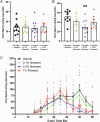Polymodal K+ channel modulation contributes to dual analgesic and anti-inflammatory actions of traditional botanical medicines
- PMID: 39198706
- PMCID: PMC11358443
- DOI: 10.1038/s42003-024-06752-y
Polymodal K+ channel modulation contributes to dual analgesic and anti-inflammatory actions of traditional botanical medicines
Abstract
Pain and inflammation contribute immeasurably to reduced quality of life, yet modern analgesic and anti-inflammatory therapeutics can cause dependence and side effects. Here, we screened 1444 plant extracts, prepared primarily from native species in California and the United States Virgin Islands, against two voltage-gated K+ channels - T-cell expressed Kv1.3 and nociceptive-neuron expressed Kv7.2/7.3. A subset of extracts both inhibits Kv1.3 and activates Kv7.2/7.3 at hyperpolarized potentials, effects predicted to be anti-inflammatory and analgesic, respectively. Among the top dual hits are witch hazel and fireweed; polymodal modulation of multiple K+ channel types by hydrolysable tannins contributes to their dual anti-inflammatory, analgesic actions. In silico docking and mutagenesis data suggest pore-proximal extracellular linker sequence divergence underlies opposite effects of hydrolysable tannins on different Kv1 isoforms. The findings provide molecular insights into the enduring, widespread medicinal use of witch hazel and fireweed and demonstrate a screening strategy for discovering dual anti-inflammatory, analgesic small molecules.
© 2024. The Author(s).
Conflict of interest statement
The authors declare no competing interests.
Figures










References
-
- CDC. Wide-ranging Online Data for Epidemiologic Research(WONDER) (CDC, 2020).
-
- Spencer, M. R., Garnett, M. F., Miniño, A. M. Drug Overdose Deaths in the United States, 2022-2022. NCHS Data Brief No. 491 https://www.cdc.gov/nchs/data/databriefs/db491.pdf (2024). - PubMed
-
- NCCIH. Chronic Pain: What You Need to Know (NCCIH, 2023).
-
- Collom, A. B. Tears of the poppy; a review of the history of opium. J. Kans. Med. Soc.58, 614 (1957). - PubMed
Publication types
MeSH terms
Substances
Grants and funding
- R01AI168063/U.S. Department of Health & Human Services | NIH | National Institute of Allergy and Infectious Diseases (NIAID)
- R01 AI168063/AI/NIAID NIH HHS/United States
- U01AI160397/U.S. Department of Health & Human Services | NIH | National Institute of Allergy and Infectious Diseases (NIAID)
- GM130377/U.S. Department of Health & Human Services | NIH | National Institute of General Medical Sciences (NIGMS)
- R35 GM130377/GM/NIGMS NIH HHS/United States

